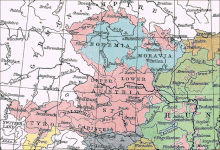Sudeten German Party
Sudeten German Party Sudetendeutsche Partei | |
|---|---|
 | |
| Secretary | Konrad Henlein |
| Founded | 1 October 1933 |
| Dissolved | 5 November 1938 |
| Merger of | DNSAP, DNP |
| Merged into | NSDAP |
| Headquarters | Aš, later shifted to Cheb[1] |
| Newspaper | Die Zeit |
| Paramilitary wings | Volkssport, SFK, FS,[2] |
| Membership | 1.35 million (1938 est.) |
| Ideology | Nazism |
Politics of Czechoslovakia | |
The Sudeten German Party (German: Sudetendeutsche Partei, SdP, Czech: Sudetoněmecká strana) was created by Konrad Henlein under the name Sudetendeutsche Heimatfront ("Front of the Sudeten German Homeland") on 1 October 1933, some months after the First Czechoslovak Republic had outlawed the German National Socialist Workers' Party (Deutsche Nationalsozialistische Arbeiterpartei, DNSAP). In April 1935, the party was renamed Sudetendeutsche Partei following a mandatory demand of the Czechoslovak government. The name was officially changed to Sudeten German and Carpathian German Party (Sudetendeutsche und Karpatendeutsche Partei) in November 1935.
With the rising power of
Background
In 1903, a group of

At the end of
SHF
The SHF was founded on 1 October 1933.
Konrad Henlein
The newly established SdP did not see itself as a successor of the DNSAP; in fact, SdP leader
In the

After the Austrian Anschluss Henlein first met Hitler on 28 March 1938. His policy was the so-called Grundplanung OA (Basic Planning) of summer 1938 and later in the interior policy of the Protectorate of Bohemia and Moravia. In March 1938 the Farmers League joined the SdP, as well as many Christian Social deputies in the Czechoslovak parliament. At a convention in Carlsbad on 24 April the majority of the party advocated the demand of the Sudeten Germans as an autonomous ethnic group, the separation of a self-governing German settlement area and the freedom to decide for annexation to Nazi Germany. At this time the SdP had about 1.35 million members.
Annexation
In September 1938 the policy of SdP succeeded in the German annexation of Sudetenland according to the
As of October 1938 the SdP/KdP parliamentary club had 52 members from the Chamber of Deputies, and their joint Senate club had 26 members. On 30 October 1938 the parliamenary mandates of 46 deputies and 22 Senators of SdP and KdP were annulled.[4]
The SdP branches in areas that remained in Czechoslovakia after the Sudetenland annexation formed the German People's Group in Czecho-Slovakia (Deutsche Volksgruppe in der Tschecho-Slowakei).[5][6][full citation needed]
Electoral results
| Election year | # of overall votes |
% of overall vote |
# of overall seats won |
+/– | Leader |
|---|---|---|---|---|---|
1935
|
1,249,534 (#1) | 15.2 | 44 / 300
|
Konrad Henlein |
| Election year | # of overall votes |
% of overall vote |
# of overall seats won |
+/– | Leader |
|---|---|---|---|---|---|
1935
|
1,092,255 (#1) | 15.0 | 22 / 150
|
Konrad Henlein |
See also
- Germans in Czechoslovakia (1918–1938)
- Sudetendeutsches Freikorps
- Sudetenland
- Nazi Party
- Karl Hermann Frank
References
This article needs additional citations for verification. (April 2009) |
- ^ Kurt Nelhiebel (1962). Die Henleins gestern und heute: Hintergründe und Ziele des Witikobundes. Röderberg. p. 70.
- ^ Freiwilliger deutscher Schutzdienst
- ^ Hruška, Emil (2013), Boj o pohraničí: Sudetoněmecký Freikorps v roce 1938 (1st ed.), Prague: Nakladatelství epocha, Pražská vydavatelská společnost, p. 11
- ^ ISBN 978-87-983829-3-5.
- ISBN 978-87-983829-3-5.
- ^ The Twentieth Century. Nineteenth Century and After. 1939. p. 395.
- The German Dictatorship, The Origins, Structure, and Effects of National Socialism, Karl Dietrich Bracher, trans. by Jean Steinberg, Praeger Publishers, NY, 1970. pp 50–54.
- Marek, Pavel; Dieter Schallner (2000). "Sudetendeutsche Partei - Sudetoněmecká strana". In Pavel Marek; et al. (eds.). Přehled politického stranictví na území českých zemí a Československa v letech 1861-1998. Olomouc: Katedra politologie a evropských studií ISBN 80-86200-25-6.
